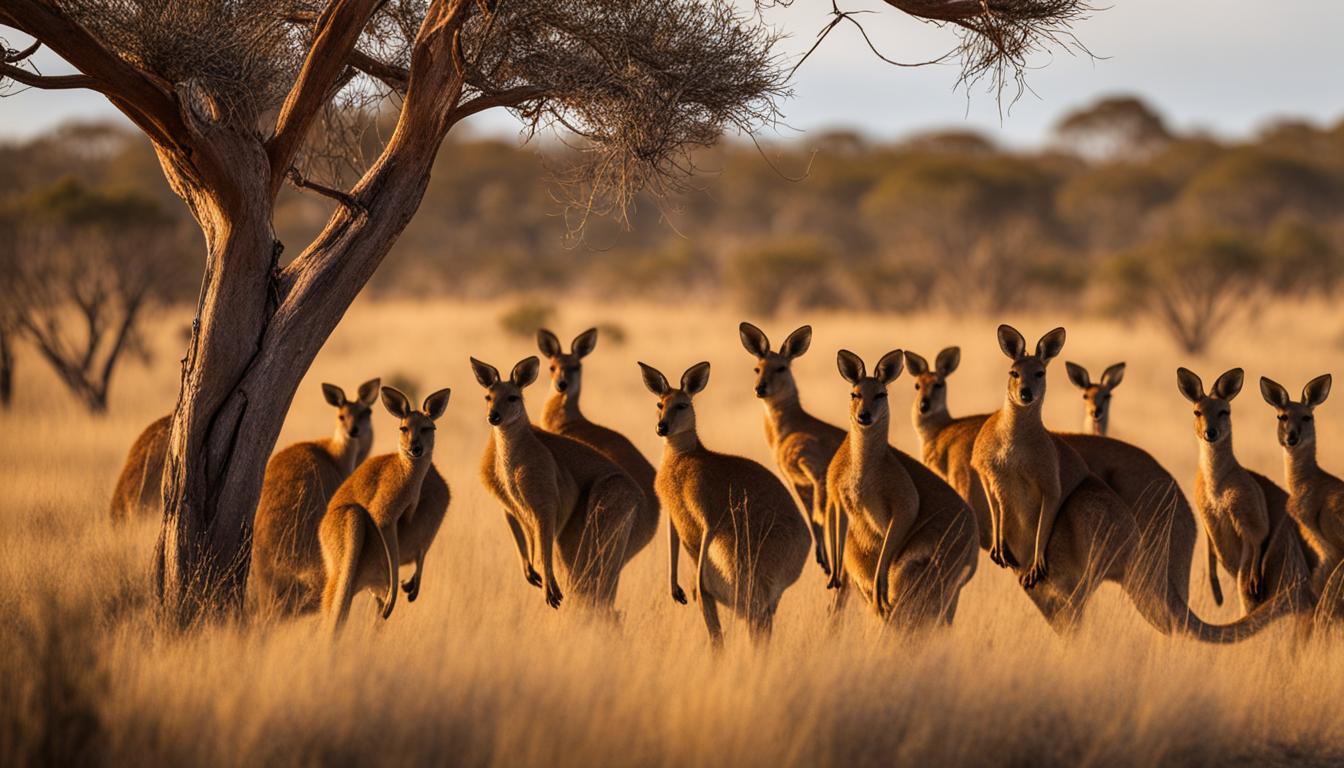Welcome to our article on kangaroo conservation, where we explore the essential efforts aimed at safeguarding these iconic Australian creatures. Kangaroos play a vital role in maintaining the ecological balance as herbivores, distributing seeds, and supporting vegetation. They are not only significant for the Australian ecosystem but also hold cultural importance, representing the unique wildlife and identity of Australia.
In this article, we will delve into the various threats faced by kangaroos, the role of government and NGOs in their conservation, the importance of balancing conservation with economic needs, land conservation and restoration efforts, engaging citizens in conservation, raising awareness, and how these efforts contribute to the welfare and protection of kangaroos.
Let’s begin this journey by understanding the challenges and initiatives involved in kangaroo conservation efforts.
Threats to kangaroo conservation
Kangaroos are facing numerous threats that jeopardize their conservation efforts. These threats primarily stem from habitat loss due to human activities, climate change, hunting, and culling. Each of these factors contributes to the decline in kangaroo populations and poses significant challenges to their survival.
Habitat loss: Human activities such as urban development, agriculture, and deforestation have resulted in the degradation and fragmentation of kangaroo habitats. As their natural habitats shrink, kangaroos face difficulties finding suitable food sources and safe shelter.
Climate change: The rapidly changing climate poses a grave risk to kangaroo populations. Rising temperatures, altered rainfall patterns, and more frequent extreme weather events directly impact their habitats and food availability, leading to reduced reproductive success and increased mortality rates.
Hunting and culling: While kangaroo hunting is legal in Australia under strict regulations, it can become unsustainable when not managed properly. Overhunting can deplete populations, disrupt the ecological balance, and negatively impact genetic diversity. Similarly, culling programs implemented to control kangaroo populations can be harmful if not based on scientific evidence and careful monitoring.
It is essential to address these threats and implement effective measures for habitat preservation, population management, and species conservation. With proper management and collaborative efforts, we can ensure the survival and well-being of kangaroos for future generations.
| Threat | Description |
|---|---|
| Habitat loss | Human activities such as urban development, agriculture, and deforestation result in shrinking and fragmentation of kangaroo habitats. |
| Climate change | Rising temperatures, altered rainfall patterns, and extreme weather events impact kangaroo habitats and food availability. |
| Hunting and culling | Unsustainable hunting practices and culling programs can deplete populations and disrupt the ecological balance. |
Government and NGO Role in Kangaroo Conservation
Kangaroo conservation efforts are led by both government agencies and non-governmental organizations (NGOs) that work together to protect these iconic Australian marsupials. The government plays a crucial role in creating and enforcing laws and regulations to safeguard kangaroos and their habitats. These regulations include restrictions on hunting, culling, and land development in kangaroo habitats. By implementing conservation strategies and programs, the government aims to ensure the long-term survival of kangaroo populations.
NGOs also play a vital role in kangaroo conservation. These organizations provide support, funding, and resources for various conservation initiatives. They often collaborate with government agencies, local communities, and researchers to develop and implement conservation programs. NGOs work towards raising awareness about the importance of kangaroo conservation and mobilize public support for protecting these marsupials and their habitats.
Several prominent kangaroo conservation organizations are actively involved in the preservation and welfare of kangaroo populations. These organizations undertake research, habitat restoration, and advocacy efforts to ensure the sustainable management of kangaroo populations. They also engage in public outreach and education programs to promote a deeper understanding of the challenges facing kangaroos and the need for their conservation.
| Government Role in Kangaroo Conservation | NGO Role in Kangaroo Conservation |
|---|---|
| Creating and enforcing laws and regulations | Providing support, funding, and resources |
| Restrictions on hunting, culling, and land development | Collaborating with government agencies and local communities |
| Conservation strategy development and implementation | Raising awareness and mobilizing public support |
| Long-term population management | Undertaking research, habitat restoration, and advocacy |
Government and NGO Collaboration
Collaboration between government agencies and NGOs is crucial for the effective conservation of kangaroos. By working together, they can combine their expertise, resources, and networks to develop comprehensive conservation strategies and programs. Government agencies provide the regulatory framework and institutional support necessary for conservation efforts, while NGOs contribute their specialized knowledge and grassroots support. This collaboration ensures a holistic approach to kangaroo conservation, addressing both the regulatory and practical aspects of protecting these unique marsupials.
Through joint initiatives, government agencies and NGOs can enhance research and monitoring efforts, implement habitat restoration projects, and engage local communities in conservation activities. By pooling their resources and expertise, they can maximize the impact of their conservation programs and achieve long-term positive outcomes for kangaroo populations and their habitats.
Balancing Kangaroo Conservation with Economic Needs
Protecting kangaroos is not only essential for their survival but also for the long-term sustainability of Australia’s economy. To strike a balance between kangaroo conservation and economic development, sustainable practices need to be implemented.
1. Ecotourism:
One way to support kangaroo conservation while promoting economic growth is through the development of ecotourism initiatives. Ecotourism allows visitors to experience kangaroos in their natural habitats while generating revenue for local communities. Guided tours, wildlife photography workshops, and nature trails create opportunities for tourists to appreciate kangaroos and their natural environment.
2. Sustainable Agriculture:
Agricultural practices should prioritize sustainable land management to protect kangaroo habitats. Through responsible grazing and use of rotational grazing techniques, farmers can effectively coexist with kangaroos. Implementing wildlife-friendly fencing and maintaining buffer zones around protected areas will help mitigate the negative impact of agricultural activities on kangaroo populations.
3. Research and Development:
Investing in research and development can lead to innovative solutions that benefit both kangaroo conservation and economic development. For example, the development of sustainable kangaroo-based products, such as kangaroo leather, can provide economic opportunities while promoting the use of renewable resources. Additionally, research into alternative land use practices, such as agroforestry or carbon farming, can contribute to both conservation and economic goals.
4. Collaboration and Education:
Collaboration between government agencies, NGOs, local communities, and the business sector is crucial for successful kangaroo conservation and economic development. By working together, stakeholders can develop comprehensive strategies that address the needs of both kangaroos and the economy. Educational programs and awareness campaigns can also play a significant role in fostering understanding and support for sustainable practices.
| Sustainable Practices | Economic Benefits | Conservation Impact |
|---|---|---|
| Ecotourism | Revenue from tourist activities | Preservation of kangaroo habitats |
| Sustainable Agriculture | Improved farming practices | Protection of kangaroo populations |
| Research and Development | Innovation and new economic opportunities | Sustainable use of kangaroo resources |
| Collaboration and Education | Enhanced stakeholder engagement | Increased support for conservation efforts |
Land Conservation and Restoration for Kangaroos
Kangaroos, as vital components of the Australian ecosystem, rely on suitable habitats for their survival. Land conservation and restoration efforts play a crucial role in protecting these iconic marsupials and their habitats. Through initiatives such as kangaroo sanctuaries, wildlife reserves, and habitat restoration projects, we can ensure the long-term preservation of kangaroo populations.
One key aspect of land conservation for kangaroos is the establishment of sanctuaries. These protected areas provide a safe haven for kangaroos, free from human interference and potential threats. Sanctuaries aim to mimic natural habitats, offering adequate resources such as food, water, and shelter. By creating these designated areas, we enable kangaroo populations to thrive and maintain their crucial ecological role.
Additionally, wildlife reserves contribute to the conservation of kangaroos by preserving large tracts of land for their habitat. These reserves focus on maintaining biodiversity and protecting natural ecosystems, providing a suitable environment for kangaroos and other native wildlife. The management of these reserves involves careful monitoring of kangaroo populations, ensuring their numbers remain sustainable and their habitats remain intact.
Habitat restoration efforts also play a significant role in land conservation for kangaroos. These initiatives involve restoring degraded habitats, such as areas affected by land clearing or invasive species. By replanting native vegetation and implementing measures to control and eradicate invasive species, we can enhance the quality of kangaroo habitats, providing them with the necessary resources for their survival.
Table: Kangaroo Sanctuaries and Wildlife Reserves
| Sanctuary/Reserve Name | Location | Size (acres) |
|---|---|---|
| Kangaroo Haven | Victoria | 500 |
| Outback Wildlife Reserve | South Australia | 2,000 |
| Coastal Kangaroo Sanctuary | New South Wales | 1,200 |
| Great Barrier Wildlife Reserve | Queensland | 5,000 |
| Tasmanian Kangaroo Conservation Area | Tasmania | 3,500 |
By combining the establishment of sanctuaries, wildlife reserves, and habitat restoration efforts, we can ensure the preservation of kangaroo populations and their natural environments. These initiatives are crucial for the conservation of kangaroo habitats and the continued survival of these iconic Australian species.

Engaging citizens in kangaroo conservation
Engaging citizens in kangaroo conservation is crucial for the long-term protection and welfare of these iconic Australian creatures. By actively involving local communities in monitoring kangaroo populations and raising awareness about the importance of conservation efforts, we can make a meaningful difference in safeguarding their habitats and promoting sustainable practices.
Citizen science plays a vital role in kangaroo conservation, as it allows individuals to contribute their observations and data to ongoing research projects. By participating in citizen science initiatives, such as kangaroo population surveys or habitat assessments, community members become active contributors to the conservation process. This involvement not only empowers citizens but also provides valuable insights and information that can guide conservation strategies and decision-making.
In addition to citizen science, community involvement in kangaroo conservation can take various forms. Local organizations and grassroots movements can organize educational workshops, awareness campaigns, and community events to highlight the importance of kangaroo protection. By fostering a sense of ownership and responsibility among community members, these initiatives create a collective effort to protect kangaroos and their habitats.
To further engage citizens, creating opportunities for hands-on experiences can be impactful. Volunteer programs that involve direct involvement in kangaroo conservation activities, such as habitat restoration projects or wildlife monitoring, not only provide valuable assistance but also foster a deep connection between individuals and the natural environment.
By actively engaging citizens in kangaroo conservation, we can build a stronger foundation for long-term protection and sustainable management. The collective efforts of individuals, community organizations, and citizen scientists can contribute to the preservation of kangaroos and their habitats, ensuring that future generations can continue to admire and appreciate these unique Australian icons.
Educating and Raising Awareness for Kangaroo Conservation
One of the key aspects of kangaroo conservation is education and raising awareness about the importance of protecting these iconic Australian species. By educating the public, we can foster a sense of understanding and empathy towards kangaroos and their habitats, encouraging individuals to take action and contribute to conservation efforts.
Outreach programs play a vital role in engaging communities and spreading knowledge about kangaroo conservation. These programs can take various forms, including workshops, seminars, and educational campaigns. By providing information about the threats facing kangaroos, such as habitat loss and climate change, these programs empower individuals to make informed choices that positively impact the survival of these unique creatures.
One effective way to educate and raise awareness about kangaroo conservation is through the use of interactive and engaging materials. For example, creating educational videos or virtual reality experiences that allow people to learn about kangaroos and their habitats in an immersive way can be both informative and entertaining. These materials can be easily shared on social media platforms, reaching a wide audience and promoting the importance of conservation.
The Power of Citizen Science
In addition to formal education and outreach programs, citizen science plays a crucial role in kangaroo conservation. Encouraging citizens to actively participate in monitoring kangaroo populations and collecting data can provide valuable insights into their distribution, behavior, and health. This collaborative approach not only helps researchers gather data on a large scale but also fosters a sense of ownership and connection to the conservation process among participants.
By engaging citizens in hands-on activities such as kangaroo population surveys or habitat monitoring, we empower individuals to become stewards of their local environments. This sense of empowerment can lead to long-term sustainable practices and a greater appreciation for the importance of kangaroo conservation.
| Benefits of Education and Outreach Programs |
|---|
| Raises awareness about the importance of kangaroo conservation |
| Empowers individuals to make informed choices |
| Encourages community involvement and citizen science |
| Spreads knowledge and understanding of kangaroo habitats and threats |
Education and outreach programs are essential for kangaroo conservation. By educating the public, fostering a sense of empathy, and engaging citizens in conservation efforts, we can ensure the long-term survival of kangaroos and their habitats. Together, we can make a difference in protecting these iconic Australian species for future generations.
Conclusion
Kangaroo conservation is crucial for the survival of this iconic Australian species. As herbivores, kangaroos play a vital role in maintaining the Australian ecosystem by distributing seeds and preserving vegetation. They also serve as a significant food source for predators. Protecting kangaroos is not only important for their welfare, but also for the overall ecological balance.
However, kangaroos face numerous threats that put their conservation at risk. Habitat loss due to human activities, climate change, hunting, and culling pose significant challenges. These threats have sparked debates among conservationists about the best approach to ensure kangaroo population management.
Efforts to protect kangaroos involve collaboration between the government, NGOs, and communities. The government establishes laws and regulations, while NGOs provide essential support, funding, and resources. Engaging citizens in conservation efforts through citizen science and community involvement is crucial to monitor kangaroo populations and raise awareness.
To strike a balance between kangaroo conservation and economic needs, sustainable practices like ecotourism and sustainable agriculture should be implemented. Land conservation and restoration initiatives, such as creating kangaroo sanctuaries and wildlife reserves, are essential for preserving their habitats. Education and outreach programs play a vital role in raising awareness about the threats facing kangaroos and empowering individuals to contribute to their protection.
How are Conservation Efforts Impacting the Current Status of Kangaroo Populations?
Conservation efforts play a crucial role in maintaining the conservation status of kangaroos. By protecting their habitats, implementing sustainable hunting practices, and raising public awareness, these efforts have helped stabilize and even increase kangaroo populations in certain regions. Without these initiatives, the conservation status of kangaroos would be at greater risk.
FAQ
What are the key conservation efforts to protect kangaroos?
Conservation efforts to protect kangaroos include habitat preservation, population management, and the establishment of kangaroo sanctuaries and wildlife reserves. Measures like habitat restoration and wildlife corridors are also implemented to protect kangaroo habitats.
What are the threats to kangaroo conservation?
Kangaroos face threats from habitat loss, hunting, climate change, and culling. These threats impact their survival and are a point of contention among conservationists.
What is the role of the government and NGOs in kangaroo conservation?
The government creates laws and regulations to protect kangaroos, while NGOs provide support, funding, and resources for conservation efforts. Collaboration between the two is crucial for effective kangaroo conservation.
How can kangaroo conservation be balanced with economic needs?
Balancing kangaroo conservation with economic needs involves implementing sustainable practices such as ecotourism and sustainable agriculture. This ensures the protection of kangaroos while promoting economic development.
What efforts are made for land conservation and restoration for kangaroos?
Land conservation and restoration efforts include establishing kangaroo sanctuaries, creating wildlife reserves, and implementing measures like habitat restoration and wildlife corridors to protect kangaroo habitats.
How can citizens be involved in kangaroo conservation?
Citizen science and community involvement are important for kangaroo conservation. Engaging citizens in monitoring kangaroo populations and raising awareness helps protect their habitats and promote conservation efforts.
What is the importance of educating and raising awareness for kangaroo conservation?
Education and outreach programs play a vital role in raising awareness about the importance of kangaroo conservation. These programs help people understand the threats facing kangaroos and provide information on how individuals can contribute to their protection.
Why is kangaroo conservation crucial?
Kangaroo conservation is crucial for the survival of this iconic Australian species. Threats such as habitat loss, hunting, and climate change highlight the importance of conservation efforts. Collaboration between government, NGOs, and communities is key to protecting kangaroos and preserving their habitats for future generations.







